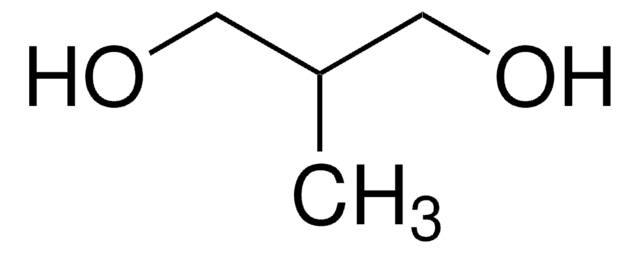H2201
1,7-Heptanediol
95%
Synonym(s):
Heptamethylene glycol
Sign Into View Organizational & Contract Pricing
All Photos(1)
About This Item
Linear Formula:
HO(CH2)7OH
CAS Number:
Molecular Weight:
132.20
Beilstein:
1633482
EC Number:
MDL number:
UNSPSC Code:
12352100
PubChem Substance ID:
NACRES:
NA.22
Recommended Products
Quality Level
Assay
95%
form
liquid
refractive index
n20/D 1.455 (lit.)
bp
259 °C (lit.)
mp
17-19 °C (lit.)
density
0.951 g/mL at 25 °C (lit.)
SMILES string
OCCCCCCCO
InChI
1S/C7H16O2/c8-6-4-2-1-3-5-7-9/h8-9H,1-7H2
InChI key
SXCBDZAEHILGLM-UHFFFAOYSA-N
Looking for similar products? Visit Product Comparison Guide
Storage Class Code
10 - Combustible liquids
WGK
WGK 3
Flash Point(F)
235.4 °F - closed cup
Flash Point(C)
113 °C - closed cup
Personal Protective Equipment
dust mask type N95 (US), Eyeshields, Gloves
Choose from one of the most recent versions:
Already Own This Product?
Find documentation for the products that you have recently purchased in the Document Library.
Customers Also Viewed
S V Vinogradov et al.
Biochemical and biophysical research communications, 203(2), 959-966 (1994-09-15)
Antisense oligonucleotides were modified by their ends with hydrophobic substituents which permitted enhancing their activity. The effect of hydrophobized oligonucleotides on reproduction of Herpes Simplex Virus type 1 in Vero cells was studied. Two types of oligonucleotides were used: a
Martin Stortz et al.
BMC biology, 18(1), 59-59 (2020-06-04)
Functional compartmentalization has emerged as an important factor modulating the kinetics and specificity of biochemical reactions in the nucleus, including those involved in transcriptional regulation. The glucocorticoid receptor (GR) is a ligand-activated transcription factor that translocates to the nucleus upon
Fabrian Brenz et al.
Food additives & contaminants. Part A, Chemistry, analysis, control, exposure & risk assessment, 34(2), 307-319 (2016-11-29)
Polyesters (PESs) are gaining more importance on the food contact material (FCM) market and the variety of properties and applications is expected to be wide. In order to acquire the desired properties manufacturers can combine several FCM-approved polyvalent carboxylic acids
Our team of scientists has experience in all areas of research including Life Science, Material Science, Chemical Synthesis, Chromatography, Analytical and many others.
Contact Technical Service











